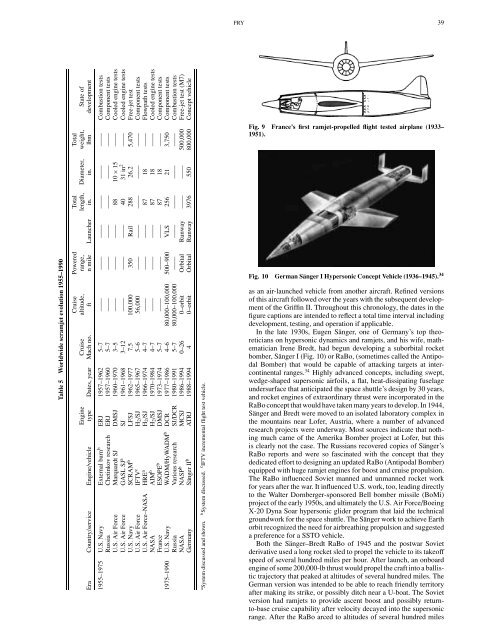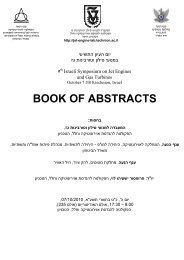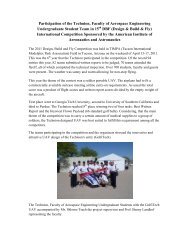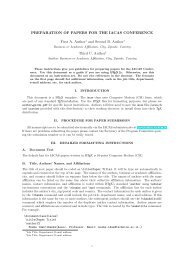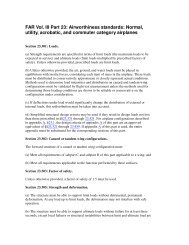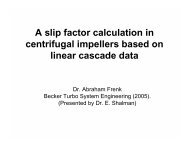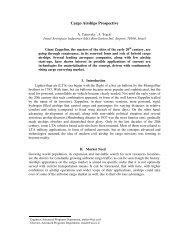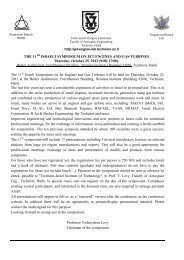A Century of Ramjet Propulsion Technology Evolution - Faculty of ...
A Century of Ramjet Propulsion Technology Evolution - Faculty of ...
A Century of Ramjet Propulsion Technology Evolution - Faculty of ...
Create successful ePaper yourself
Turn your PDF publications into a flip-book with our unique Google optimized e-Paper software.
Table 5 Worldwide scramjet evolution 1955–1990<br />
Cruise Powered Total Total<br />
Engine Cruise altitude, range, length, Diameter, weight, State <strong>of</strong><br />
Era Country/service Engine/vehicle type Dates, year Mach no. ft n mile Launcher in. in. lbm development<br />
1955–1975 U.S. Navy External burnb ERJ 1957–1962 5–7 —— —— —— —— —— —— Combustion tests<br />
Russia Chetinkov research ERJ 1957–1960 5–7 —— —— —— —— —— —— Component tests<br />
U.S. Air Force Marquardt SJ DMSJ 1960–1970 3–5 —— —— —— 88 10 × 15 —— Cooled engine tests<br />
U.S. Air Force GASL SJa SJ 1961–1968 3–12 —— —— —— 40 31 in2 —— Cooled engine tests<br />
U.S. Navy SCRAMb LFSJ 1962–1977 7.5 100,000 350 Rail 288 26.2 5,470 Free-jet test<br />
U.S. Air Force IFTVc H2/SJ 1965–1967 5–6 56,000 —— —— —— —— —— Component tests<br />
U.S. Air Force–NASA HREa H2/SJ 1966–1974 4–7 —— —— —— 87 18 —— Flowpath tests<br />
NASA AIMb H2/SJ 1970–1984 4–7 —— —— —— 87 18 —— Cooled engine tests<br />
France ESOPEb DMSJ 1973–1974 5–7 —— —— —— 87 18 —— Component tests<br />
1975–1990 U.S. Navy WADM/HyWADMb DCR 1977–1986 4–6 80,000–100,000 500–900 VLS 256 21 3,750 Component tests<br />
Russia Various research SJ/DCR 1980–1991 5–7 80,000–100,000 —— —— —— —— —— Combustion tests<br />
NASA NASPb MCSJ 1986–1994 0–26 0–orbit Orbital Runway —— —— 500,000 Free-jet test (M7)<br />
Germany Sänger IIb ATRJ 1988–1994 4 0–orbit Orbital Runway 3976 550 800,000 Concept vehicle<br />
c IFTV incremental flight test vehicle.<br />
discussed.<br />
a System discussed and shown. b System<br />
FRY 39<br />
Fig. 9 France’s first ramjet-propelled flight tested airplane (1933–<br />
1951).<br />
Fig. 10 German Sänger I Hypersonic Concept Vehicle (1936–1945). 34<br />
as an air-launched vehicle from another aircraft. Refined versions<br />
<strong>of</strong> this aircraft followed over the years with the subsequent development<br />
<strong>of</strong> the Griffin II. Throughout this chronology, the dates in the<br />
figure captions are intended to reflect a total time interval including<br />
development, testing, and operation if applicable.<br />
In the late 1930s, Eugen Sänger, one <strong>of</strong> Germany’s top theoreticians<br />
on hypersonic dynamics and ramjets, and his wife, mathematician<br />
Irene Bredt, had begun developing a suborbital rocket<br />
bomber, Sänger I (Fig. 10) or RaBo, (sometimes called the Antipodal<br />
Bomber) that would be capable <strong>of</strong> attacking targets at intercontinental<br />
ranges. 34 Highly advanced concepts, including swept,<br />
wedge-shaped supersonic airfoils, a flat, heat-dissipating fuselage<br />
undersurface that anticipated the space shuttle’s design by 30 years,<br />
and rocket engines <strong>of</strong> extraordinary thrust were incorporated in the<br />
RaBo concept that would have taken many years to develop. In 1944,<br />
Sänger and Bredt were moved to an isolated laboratory complex in<br />
the mountains near L<strong>of</strong>er, Austria, where a number <strong>of</strong> advanced<br />
research projects were underway. Most sources indicate that nothing<br />
much came <strong>of</strong> the Amerika Bomber project at L<strong>of</strong>er, but this<br />
is clearly not the case. The Russians recovered copies <strong>of</strong> Sänger’s<br />
RaBo reports and were so fascinated with the concept that they<br />
dedicated effort to designing an updated RaBo (Antipodal Bomber)<br />
equipped with huge ramjet engines for boost and cruise propulsion.<br />
The RaBo influenced Soviet manned and unmanned rocket work<br />
for years after the war. It influenced U.S. work, too, leading directly<br />
to the Walter Dornberger-sponsored Bell bomber missile (BoMi)<br />
project <strong>of</strong> the early 1950s, and ultimately the U.S. Air Force/Boeing<br />
X-20 Dyna Soar hypersonic glider program that laid the technical<br />
groundwork for the space shuttle. The Sänger work to achieve Earth<br />
orbit recognized the need for airbreathing propulsion and suggested<br />
a preference for a SSTO vehicle.<br />
Both the Sänger–Bredt RaBo <strong>of</strong> 1945 and the postwar Soviet<br />
derivative used a long rocket sled to propel the vehicle to its take<strong>of</strong>f<br />
speed <strong>of</strong> several hundred miles per hour. After launch, an onboard<br />
engine <strong>of</strong> some 200,000-lb thrust would propel the craft into a ballistic<br />
trajectory that peaked at altitudes <strong>of</strong> several hundred miles. The<br />
German version was intended to be able to reach friendly territory<br />
after making its strike, or possibly ditch near a U-boat. The Soviet<br />
version had ramjets to provide ascent boost and possibly returnto-base<br />
cruise capability after velocity decayed into the supersonic<br />
range. After the RaBo arced to altitudes <strong>of</strong> several hundred miles


